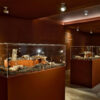Diego Velázquez is widely considered to be the master of Spanish Baroque art.
His paintings have withstood the test of time, having been featured in numerous museums and galleries around the world. His works capture the grandeur and drama of 17th century Spain, with vibrant colors and dynamic compositions.
Velázquez was a master of portraying emotion through his artwork, with subtle gestures and expressions that draw the viewer in. He was also a brilliant colorist, using shades and tones to create light and dark areas in his paintings. His use of light creates a vibrant atmosphere that captivates viewers.
In this article, we will take a look at Diego Velázquez’s life and work, as well as how he has become a renowned figure in Spanish Baroque art today.

Velázquez’s Early Life and Training
Diego Rodríguez de Silva y Velázquez was born in Seville in 1599 to a large family of the middle class. He received an education from the painter Francisco Herrera the Elder, giving him an early introduction to painting and art. He was apprenticed at a very young age and quickly gained recognition for his talent and skill.
Velázquez’s style, particularly in his early works, is often described as being rooted in realism. He painted everyday scenes as if he were recording a history of life at the time—allowing viewers to access different aspects of Spanish culture and life through his work. His use of light and color further added to this effect, providing viewers with an almost tangible connection to the people, places, and events he depicted.
With the help of Herrera’s teaching, Velázquez was able to master a more advanced painting technique than what was usually found in his era. His use of brushwork and color gradation allowed him to achieve an almost photographic level of realism in his work—which helped make him one of the most respected painters of the Spanish Baroque period.

Velázquez’s Move to the Royal Court in Madrid
Diego Velázquez rose to fame when he was hired by King Philip IV of Spain for his exceptional talent in painting. He quickly became the painter of choice for the royal court, capturing the royals in portraits.
In his early years at court, Velázquez completed an array of lavish and magnificent paintings including:
- a series of mythological scenes for the Torre de la Parada
- “The Surrender of Breda” (1634-1635)
- “Las Meninas” (1656)
Velázquez was further promoted to ‘Directo de los Reales Alcazares de Madrid’ (Director of the Royal Palaces in Madrid). His strong connection with the royal family allowed him to travel and purchase artwork from Italian masters to enrich their collections.
Velázquez’s close relationship with the court showed in his use of chiaroscuro, a style which highlighted a more realistic sense of light and shadow onto his paintings—one can argue that this helped enhance images such as Philip IV’s official portrait. He even managed to fuse traditional Spanish elements into painting techniques adopted from Italy, making Velázquez a true connector between these two European styles.
Velázquez’s Most Famous Works: Las Meninas and Las Hilanderas
Diego Velázquez is most renowned for two of his most important works: Las Meninas and Las Hilanderas.

Las Meninas
Las Meninas (The Maids of Honor) is considered by many art historians to be Velázquez’s masterpiece. It is a complex painting that serves as a reflection of the artist himself, and the court life in which he lived. Las Meninas depicts two main figures, the Infanta Margarita Theresa of Spain and her maid of honor as well as numerous other courtiers clustered around them.
This painting exemplifies Velázquez’s style of art, which emphasizes realism and naturalism in both form and color. It also displays his clever use of light, shadows, and reflections to create a sense of depth. This painting is remarkable for its intricate composition, exquisite brushwork and its skillful manipulation of space. It is truly a timeless masterpiece that has withstood the test of time.

Las Hilanderas
Velázquez’s other famous work is Las Hilanderas (The Spinners or The Fable of Arachne). This painting is unique in that it depicts an ancient Greek myth with modern realism. In this painting, we see two women at work weaving cloth on a large loom surrounded by all sorts of tools used for weaving and spinning yarns.
This painting showcases Velázquez’s masterful use of colors to create mood and atmosphere; he used blues, greens, and yellows to bring out the beauty in the scene depicted. This work also reveals his attention to detail through its accurate depiction of everyday life during his time, including all the
Velázquez’s Portraiture Style and Technique
Diego Velázquez was a master of Spanish Baroque portraiture, with his paintings often considered definitive visual representations of their time. His signature style was characterized by an unvarnished realism, free from the fantastical flourishes employed by other painters. Velázquez was an admirer of nature, and sought to accurately reflect the physical features of his sitters in a formal language that communicated the true essence of their characters.
Velázquez used a range of techniques to capture his subjects in a realistic way, creating a calm atmosphere and an intimate relationship between the viewer and painting – one in which the subject appeared as if they were ready to speak or take action. He approached each portrait as if it was a history painting, focusing on significant details that illuminated not just what his sitter looked like, but who they were as well.
Velazquez possessed an extraordinary ability to capture the traits that made each person unique and special. To achieve this level of accuracy, he worked with great attention to detail—something that can be seen in his incredible handling of light and shadow and his deceptively seamless transitions between tones and shades. He is also known for introducing dynamic poses into portrait painting – something that had rarely been seen before him. By combining these techniques, Velázquez created portraits that were not just thought-provoking but also deeply compelling works of art.
Velázquez’s Later Years and Legacy as a Master Painter

Diego Velázquez’s later years were spent serving as a court painter to Philip IV, capturing everything from portraits to large scale hunting scenes. With the title of court painter came the privilege of much higher status and pay.
It is during this period that Velázquez produced his most famous work, Las Meninas (1656). Described as a “masterpiece within a masterpiece,” this painting has been praised for its realism, for its pristine execution and for its insight into Spanish life at the court.
During his later years, Velázquez was also made a Knight of Santiago and an honorary member of the Royal Academy of San Fernando. He was so highly regarded that he was commissioned to decorate The Hall of Realms in Madrid with paintings – an impressive feat that took him four years to complete.
In 1660, he passed away in Madrid; however, his paintings continue to inspire generations today. His works are considered some of the greatest accomplishments in Spanish Baroque painting – ranging from simple portraiture all the way up to complex religious scenes and huge battle murals. His genius lives on in galleries and museums across the world, with several works by Velázquez regarded as priceless masterpieces.

Where to See Velázquez’s Paintings: Prado Museum and Beyond
Velázquez’s works can be found in many of the most important art museums in the world. The Museo del Prado in Madrid holds most of his paintings, and if you’re an admirer of Spanish Baroque painting, visiting The Prado is a must.
Here are some of Velázquez’s famous works located at the Museo del Prado:
- Las Meninas (1656): Regarded as Velázquez’s masterpiece, this painting portrays several scenes within one painting, reflecting on Spanish nobility, the court life of Spain’s ruling family and Velázquez himself.
- Waterseller of Seville (1622): This monumental painting is considered to be an ideal example of Velázquez’s early style. It is a daily life genre scene with extraordinary color coordination between different elements in the composition.
- The Spinners (1657): This masterful painting shows a group of women weaving thread with elaborate costumes and complex expressions, exploring illusions about human nature and free will.
The Louvre Museum in Paris, another major art museum, also holds several paintings by Diego Velázquez such as Gaspar de Guzman – Count-Duke Olivares (1636), which depicts Olivares’ portrait at the height of his power during Spain’s Golden Age. Other notable museums that display some of Velázquez’ works include The National Gallery in London and The Metropolitan Museum in New York City.
Diego Velázquez’s mastery of the Spanish Baroque style, his innovative use of color and light, and his ability to capture emotion and movement make him a unique figure in the history of art. His works remain some of the most recognizable, beloved, and influential images of the period. His portrait of Pope Innocent X is one of the most iconic works of the Baroque period and its influence can be seen in works of art from many different countries, cultures, and time periods. Velázquez was a true master whose work continues to influence artistic expression to this day.























